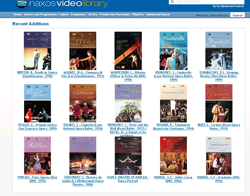Naxos, which bills itself as “the world’s leading classical music label and industry leader in streaming audio and music education,†has launched the Naxos Video Library. A unique streaming subscription music service, which complements the six-year old Naxos Music Library, the Naxos Video Library is projected to soon offer at least 500 streaming videos, subtitles in up to five languages, and other features essential to full enjoyment and appreciation of opera, music, dance, documentaries, and other musical art forms on video.
Although the video library is designed for institutional subscribers – 60 universities gave the service a try in February, the first month of its launch – Naxos will sign up individuals who approach them directly at
[email protected]. Subscriptions start at $150/year for unlimited access. Institutional subscription rates are determined by the number of simultaneous access points. A yearly subscription of $675, for example, will allow five users to access the library simultaneously from five different computers.
Labels currently represented on the site include Arthaus Musik, Dacapo, Dynamic, EuroArts, Ondine, Opus Arte, Medici Arts, Naxos, and TDK. Performers include many of the finest: tenors Placido Domingo and Luciano Pavarotti, pianist Martha Argerich, conductor Claudio Abbado, Les Arts Florissants.and baritone Gerald Finley share bandwith with a host of younger, up-and-coming artists and ensembles.
How many other libraries allow you to search by television director and sound engineer as well as artist, follow along with scrolling libretto text, and create custom clips, which can be edited and added to individual playlists? This is one luscious resource.
Speaking by phone from Naxos’ headquarters in Franklin, TN, Randall Foster, Licensing & Business Development Manager, discussed the rationale for the video library, and the decision to limit Naxos’ highest streaming sampling rate to 2 mbps.
“When we put the Naxos Video Library together,†he said, “we basically looked at ways to meet or surpass the existing streaming resources that were available. As our result, our standard streaming quality is 700 kbps, and high quality is 2 mbps. We’ve blown the picture up on a wall with a 7-foot projector, and it looks quite good. It’s not as good as Blu-ray, but to view so many videos in one place at an affordable price, we felt this brought the best value to the user.â€
Questioned about the quality of picture and sound, Foster continued, “We have to juxtapose the difference between sound fidelity and ready access to content. A 2meg file is a big file. The big goal with all our libraries that have been built innately for education is to provide the best possible listening environment with the largest possible collection of content at an affordable price. We have to monitor bandwith on our end, and the ability to access files on the user’s end.â€
A Medium All its Own
Foster stressed that the library isn’t meant to replace purchasing the DVDs or Blu-rays that anyone might want to own. Instead, it gives users access to important information on the dashboard, and allows them to pay attention to small details that are hard to catch onscreen if watched through a standard DVD player.
“We are not trying to replace the CD or the DVD,†he said. “We are trying to provide a robust listening experience where the listener has access to a much larger quantity than they would on an average daily basis.â€
Perhaps this answer explains why the Naxos Music Library, which now has well over 10,000 subscribers online, limits its music-only streaming rate to either 64 kbps (standard) or, at best, 128 kbps. “We’re not saying that it sounds like CDs,†he says, But it is ½ million tracks of music in one place. †Including Naxos’ own family of labels, the Music Library now boasts over 200 labels, 41,000 CDs and over ½ million tracks, with 1000 CDs added per month.
“I went to a University and did an A/B test between playing a CD and playing a Naxos music library,†says Foster. “We worked with 35 professors and musicologists. Nobody could hear a difference. Everyone understands that when you compress files, there is a loss of fidelity. But at this university, they couldn’t tell the difference. I know this is one test case. It’s not like I have a real scientific testing model. Nonetheless, I think the results are significant.â€
When questioned about the listening environment, Foster revealed that it included JBL monitors, which are similar to what 90% of people listen to in universities. I leave it to you to infer what this says about the quality of the monitors, cables, and entry-level equipment often seen in educational environments.
Foster himself was converted to audiophile listening after guest lecturing about music licensing at the University of Texas in El Paso. The department chair, who was a good friend, invited him over to his house for dinner and music listening.
“I walked in to the most gorgeous set-up, with Wilson Audio Sashas and PS Audio gear. It opened my mind to the sonic possibilities we can achieve. I ended up picking up an entire Emotiva system from their location across the street, and am currently using two Emotiva monoblocks at home. But I admit that I didn’t used to put stock in this kind of set-up.â€
Which brings us full circle. As an educational and reference library, the Naxos Video and Music Libraries cannot be beat. For lovers of high-definition and audiophile quality sound, they are invaluable resource for deciding what to purchase for the ultimate viewing and listening experience.





